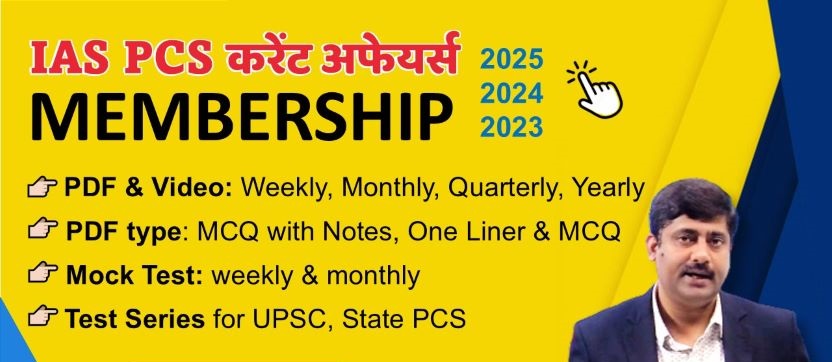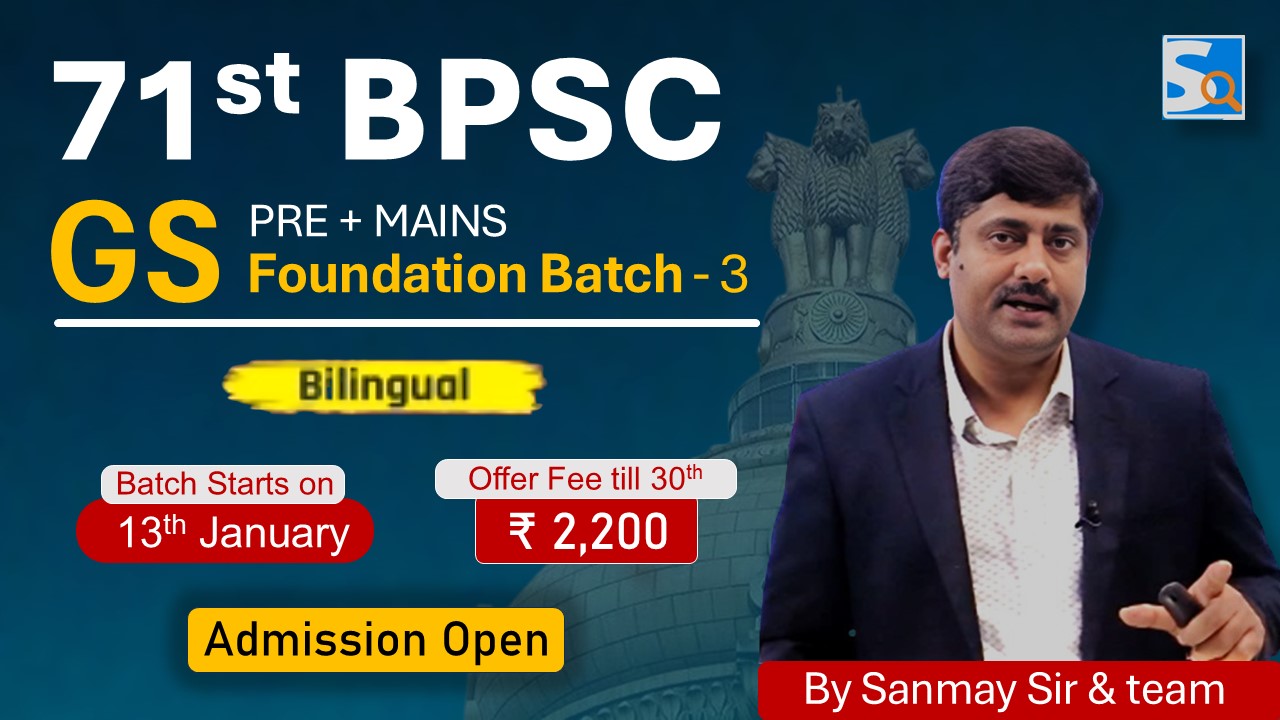This is the current affairs of 31 January 2025. Here are questions and answers of daily current affairs for better preparation of competitive exams for government jobs.
PDF Download: Click here
1. India and which country, after several years, agreed to start direct flights, visas, multiple exchanges and Mansarovar Yatra for pilgrims in summer?
a. Pakistan
b. Bangladesh
c. Nepal
d. China
Answer: d. China
– Decisions were made to revive various measures during the meeting between Foreign Secretary Vikram Misri and Chinese Deputy Foreign Minister Sun Weidong in Beijing on January 27, 2025.
– Both countries agreed on concrete measures to resume direct flights, visas, multiple exchanges, and the Mansarovar pilgrimage for pilgrims this summer. No date has been announced yet for the implementation of these measures.
– Chinese Foreign Minister Wang Yi called for an end to “mutual suspicion and misunderstandings” between the two countries.
About Kailash Mansarovar
– Kailash Mansarovar is one of the holiest religious sites for Hindus.
– Mount Kailash is considered the sacred abode of Lord Shiva and Goddess Parvati. This mountain is believed to be 30 million years old.
– Jains, Buddhists, and Tibetans also hold this mountain in high religious regard.
– Every Indian citizen needs a visa to visit Kailash Mansarovar since Mount Kailash is in Tibet, which is under China’s control.
Three Routes to Kailash Mansarovar
– Lipulekh Pass Route (Uttarakhand): The journey takes 24 days.
– Nathu La Pass Route (Sikkim): The journey takes 21 days.
– Shigatse Route (Tibet): The journey takes 13 nights and 14 days.
– Two Agreements for Kailash Mansarovar Pilgrimage
In May 2013, the first agreement between India and China allowed the Kailash Mansarovar pilgrimage via the Lipulekh Pass route.
– In September 2014, the second agreement between India and China permitted the Kailash Mansarovar pilgrimage via the Nathu La Pass route.
—–
When Were Flight Services and Mansarovar Yatra Suspended?
– Kailash Mansarovar Yatra and flight services between India and China had been suspended since 2020.
– In June 2020, the Doklam standoff occurred between India and China.
– The first wave of COVID-19 hit in March 2020.
– Before the COVID-19 pandemic, there were 539 flights per month between the two countries.
Note: The India-China agreement of 1954 allowed this pilgrimage. However, due to the Tibetan uprising in 1959 and the India-China war in 1962, the yatra was suspended. It was resumed in 1981 after an agreement between India and China. The pilgrimage was later halted again due to COVID-19 and is now expected to resume in 2025.
When Did Relations Between India and China Start Improving?
– According to the Ministry of External Affairs (MEA), as agreed upon during the meeting between Prime Minister Narendra Modi and President Xi Jinping in Kazan in October 2024, both sides conducted a comprehensive review of India-China bilateral relations and agreed to take certain people-centric steps to stabilize and restore ties.
Upcoming Meetings on Key Issues
– India’s and China’s technical teams will soon discuss resuming direct flight services.
– Media and think tank dialogues will be encouraged to enhance cooperation and understanding.
– Both countries will jointly celebrate the 75th anniversary of their diplomatic relations.
– Experts will hold meetings to discuss sharing water data and cooperation on transboundary rivers.
– No specific dates for these meetings have been announced yet.
Indian Pilgrims’ View of Kailash Peak from Indian Territory
– The first batch of pilgrims saw Kailash Peak from within Indian territory in October 2024.
– Pilgrims viewed Kailash Peak (Kailash Mansarovar Yatra) from the Old Lipulekh Pass.
– The pass is situated at an altitude of 17,000 feet above sea level.
– To witness the Kailash Peak, pilgrims must trek 2.5 km to reach Old Lipulekh Pass.
– Previously, pilgrims had to enter the Tibet Autonomous Region to get a view of the peak.
– Mount Kailash is considered the abode of Lord Shiva.
Who Discovered This Viewing Spot?
– A few months before October 2024, a team from the Uttarakhand Tourism Department, Border Roads Organization (BRO), and Indo-Tibetan Border Police (ITBP) discovered the location from where Mount Kailash is clearly visible.
————–
2. Which two Indian cities have been included in the list of global wetland recognized cities?
a. Indore and Udaipur
b. Bengaluru and Hyderabad
c. Indore and Bengaluru
d. Udaipur and Hyderabad
Answer: a. Indore and Udaipur
– The list of 31 newly recognized wetland cities was announced during the 64th meeting of the Standing Committee on January 24, 2025.
– Indore (Madhya Pradesh) and Udaipur (Rajasthan) became the first two Indian cities to receive international recognition as ‘Wetland Cities’.
– With this, the total number of recognized wetland cities has reached 74.
– Prime Minister Narendra Modi congratulated Indore and Udaipur for being included in the Ramsar Convention’s list of 31 newly recognized wetland cities worldwide.
– In December 2024, the Ministry of Environment, Forest, and Climate Change nominated three Indian cities—Indore, Udaipur, and Bhopal—for Wetland City Recognition.
– Among these, Indore and Udaipur were selected.
– Wetlands play a crucial role in flood control, ecological conservation, and mitigating extreme climate events.
Recognized Indian Wetland Cities
1. Indore
– Indore is India’s cleanest city.
– It has a Ramsar site, Sirpur Lake, which is an important waterbird congregation area and is being developed as a bird sanctuary.
2. Udaipur
– Udaipur is known as the City of Lakes.
– It has five significant wetlands: Pichola, Fatehsagar, Rang Sagar, Swaroop Sagar, and Doodh Talai.
31 newly recognized wetland cities
– Argentina: Trelew
– Belgium: Mechelen
– Botswana: Kasane-Kazungula, Shakawe
– Chile: Valdivia
– China: Chongming, Dali, Fuzhou, Hangzhou, Jiujiang, Lhasa, Suzhou, Wenzhou, Yueyang
– France: Abbeville, Arles, Hampigny
– India: Indore, Udaipur
– Iran (Islamic Republic of): Babol, Bandar Kiahar, Gandoman
– Japan: Nagoya City
– Morocco: Mehdya
– Philippines: Balanga City
– Poland: Poznan
– Republic of Korea: Gimhae, Mungyeong
– Serbia: Novi Sad
– Switzerland: Geneva
– Zimbabwe: Victoria Falls
About Wetland City Accreditation (WCA)
– Recognized Wetland City (WCA) is a voluntary accreditation system.
– It was established under the Ramsar Convention during the COP12 Conference in 2015.
– This accreditation is given to cities that have taken effective measures to protect their urban wetlands.
What is a Wetland?
– Wetlands are moist land areas where water accumulates during the rainy season. These areas also support a large variety of bird species.
– In recent years, several sites have been designated as Ramsar Sites, and UNESCO provides assistance for their conservation.
– World Wetlands Day is celebrated every year on February 2.
About Ramsar Sites
– Why are they called Ramsar Sites?
– Ramsar is a city in Iran.
– On February 2, 1971, an agreement called the Ramsar Convention on Wetlands was signed by various countries in this city.
– Due to this, it is called the Ramsar Agreement, and some also refer to it as the Wetland Convention.
– It came into effect in 1975.
Key Facts About the Ramsar Convention:
– The official name of this treaty is:
“Convention on Wetlands of International Importance, especially as Waterfowl Habitat”.
– It is an intergovernmental treaty that provides guidance for the conservation and sustainable use of wetlands.
– India signed the treaty in 1982.
– In India, the Ministry of Environment, Forest, and Climate Change is the nodal ministry responsible for wetland conservation.
85 Ramsar sites in India (by August 2024)
1. Asthmudi Wetland, Kerala
2. Beas Conservation Reserve, Punjab
3. Bhitarkanika Mangroves, Orissa
4. Bhoj Wetlands, MP
5. Chandertal Wetland, Himachal Pradesh
6. Chilka Lake, Orissa
7. Deepor Beel, Assam
8. East Kolkata Wetlands, West Bengal
9. Harike Lake, Punjab
10. Hokera Wetland, Jammu and Kashmir
11. Kanjli Lake, Punjab
12. Keoladeo Ghana NP, Rajasthan
13. Keshopur-Mian Community Reserve, Punjab
14. Kolleru Lake, Andhra Pradesh
15. Loktak Lake, Manipur
16. Nalsarovar Bird Sanctuary, Gujarat
17. Nandur Madmaheshwar, Maharashtra
18. Nangal Wildlife Sanctuary, Punjab
19. Nawabganj Bird Sanctuary, Uttar Pradesh
20. Parvati Agra Bird Sanctuary, Uttar Pradesh
21. Point Calimere Wildlife and Bird Sanctuary, Tamil Nadu
22. Pong Dam Lake, Himachal Pradesh
23. Renuka Wetland, Himachal Pradesh
24. Ropar Lake, Punjab
25. Rudrasagar Lake, Tripura
26. Saman Bird Sanctuary, Uttar Pradesh
27. Samaspur Bird Sanctuary, Uttar Pradesh
28. Sambhar Lake, Rajasthan
29. Sandi Bird Sanctuary, Uttar Pradesh
30. Sarsai Nawar, Uttar Pradesh
31. Sasthamkotta Lake, Kerala
32. Sundarban Wetland, West Bengal
33. Surinsar-Mansar Lakes, Jammu and Kashmir
34. Tsomoriri Lake, Jammu and Kashmir
35. Upper Ganga River, UP
36. Vembanad Coal Wetland, Kerala
37. Wular Lake, Jammu and Kashmir
38. Asan Conservation Reserve, Uttarakhand
39. Kabartal (Kanwar Lake), Bihar
40. Keetham Lake (Surasarovar), UP
41. Lonar Lake, Maharashtra
42. ‘Startasapuk Tso’ and ‘Tso Kar’ Lake, Ladakh
43. Sultanpur National Park, Haryana
44. Bhidawas Wildlife Sanctuary, Haryana
45. Thol Lake Wildlife Sanctuary, Gujarat
46. Wadhwana Wetland Area, Gujarat
47. Haiderpur Wetland, Uttar Pradesh
48. Khijadiya Bird Sanctuary, Gujarat
49. Bakhira Wildlife Sanctuary, Uttar Pradesh
50. Karikili Bird Sanctuary, Tamil Nadu
51. Pallikaranai Marsh Reserve Forest, Tamil Nadu
52. Pichavaram Mangroves, Tamil Nadu
53. Pala Wetland, Mizoram
54. Sakhya Sagar Wetland, Madhya Pradesh
55. Koothankulam Bird Sanctuary, Tamil Nadu
56. Satkosia Gorge, Odisha
57. Nanda Lake, Goa
58. ‘Gulf of Mannar Marine Biosphere Reserve’, Tamil Nadu
59. Ranganathittu Bird Sanctuary, Karnataka
60. Vembannur Wetland Complex, Tamil Nadu
61. Velode Bird Sanctuary, Tamil Nadu
62. Sirpur Wetland, Madhya Pradesh
63. Vedanthangal Bird Sanctuary, Tamil Nadu
64. Udayamarthandapuram Bird Sanctuary, Tamil Nadu
65.Tampara Lake, Odisha
66. Hirakud Reservoir, Odisha
67. Anshupa Lake, Odisha
68. Yashwant Sagar, Madhya Pradesh
69. Chitrangudi Bird Sanctuary, Tamil Nadu
70. Suchindram Theroor Wetland Complex, Tamil Nadu
71. Vaduvur Bird Sanctuary, Tamil Nadu
72. Kanjirkulam Bird Sanctuary, Tamil Nadu
73. Thane Creek, Maharashtra
74. Haigam Wetland Conservation Reserve, Jammu and Kashmir
75. Shalbug Wetland Conservation Reserve, Jammu and Kashmir
76. Ankasamudra Bird Conservation Reserve, Karnataka
77. Aghanashini Sanctuary, Karnataka
78. Magadi Kere Conservation Reserve, Karnataka
79. Karaivetti Bird Sanctuary, Tamil Nadu
80. Longwood Shola Reserve Forest, Tamil Nadu
81. Nagi Bird Sanctuary, Bihar
82. Nakti Bird Sanctuary, Bihar
83. Nanjarayan Bird Sanctuary, Tamil Nadu
84. Kazuveli Bird Sanctuary, Tamil Nadu
85. Tawa Reservoir, Madhya Pradesh
—————–
3. Which satellite did ISRO launch in January 2025 with GSLV-F14 rocket in its 100th mission?
a. NVS-01
b. NVS-02
c. EOS-07
d. INSAT-3DS
Answer: b. NVS-02
– NVS-02: Part of NavIC’s Second-Generation Satellite Series
GSLV – Geosynchronous Satellite Launch Vehicle
– The Indian Space Research Organisation (ISRO) launched the NVS-02 satellite on January 29, 2025, using the GSLV-F14 rocket.
About NVS-02
– NVS-02 is part of the second-generation series of the Navigation with Indian Constellation (NavIC) system.
– It operates with navigation payloads in L1, L5, and S-bands.
– It also includes a ranging payload in the C-band.
– It is built on the I-2K bus platform.
– The satellite weighs 2,250 kg and has a power capacity of 3 kW.
– It uses both indigenous and imported atomic clocks for precise time estimation.
What is Navigation with Indian Constellation (NavIC)?
– NavIC is India’s independent regional navigation satellite system.
– It is designed to provide accurate Position, Velocity, and Time (PVT) services to users across India and regions extending up to 1,500 km beyond Indian territory.
– NavIC offers two types of services:
1. Standard Positioning Service (SPS)
2. Restricted Service (RS)
About GSLV
– GSLV-F15 is the 17th flight of India’s Geosynchronous Satellite Launch Vehicle (GSLV).
– It features an indigenous cryogenic stage, marking its 11th flight with this technology.
– This is the 8th operational flight of GSLV with a cryogenic stage.
– The rocket has a height of 50.9 meters and weighs approximately 420 tons.
– Its primary objective is to place the NVS-02 satellite into a geosynchronous transfer orbit (GTO).
Why Was the GSLV Rocket Called the ‘Naughty Boy’?
– In February 2024, GSLV-F14 / INSAT-3DS Mission Director Tommy Joseph stated that GSLV has now become a “disciplined boy”.
– He made this remark after the successful launch of GSLV-F14.
– Earlier, GSLV was often referred to as a “Naughty Boy” due to its inconsistent success rate.
– Out of 15 launches, at least four failed, whereas:
– PSLV (Polar Satellite Launch Vehicle), considered a workhorse, has had only three failures out of 60 missions.
– LVM-3, the successor, has never failed in its seven missions.
– The nickname was linked to the challenges faced with GSLV’s cryogenic stage.
—————
4. Where were the 38th National Games held?
a. Delhi
b. Goa
c. Haryana
d. Uttarakhand
Answer: d. Uttarakhand
– Prime Minister Narendra Modi inaugurated the 38th National Games on January 28, 2025, in Dehradun, Uttarakhand.
38th National Games
– Dates: January 28 to February 14, 2025
– Venue: Dehradun, Uttarakhand
– Inauguration Venue: Rajiv Gandhi International Cricket Stadium
– Number of Participants: Approximately 10,000 athletes in 35 sports events
– Participation: 28 states and 8 Union Territories will participate.
– Note: The 37th National Games were held in Goa.
Where and How Many Events Will Be Held?
– Dehradun – 16 events
– Nainital – 9 events
– Tehri – 7 events
– Udham Singh Nagar – 6 events
– Haridwar – 3 events
– Almora – 1 event
– Champawat – 1 event
– Pithoragarh – 1 event
National Games (History)
– The National Games were first held in 1924 in Lahore, British India.
– At that time, they were known as “All India Olympic Games”.
– In 1940, the tournament’s name was changed to “National Games”.
– The first National Games after independence were held in Lucknow in 1948.
– It is organized by the Indian Olympic Association (IOA).
– The President of IOA is P.T. Usha.
Uttarakhand
– Chief Minister: Pushkar Singh Dhami
– Governor: Gurmeet Singh
– Capitals: Dehradun (Winter) and Gairsain (Summer)
————-
5. What is the mascot of the 38th National Games?
a. Moga
b. Barasingha
c. Mauli
d. Jackfruit
Answer: c. Mauli
– The name of the mascot has been derived from the state bird of Uttarakhand, the Himalayan Monal.
– It is known for its bright colors, beauty, and strength.
– Note: The mascot of the 37th National Games is Moga (Bison), a bovine animal.
—————
6. What is the theme of the 38th National Games?
a. Green Nation
b. Green Games
c. Green Uttarakhand
d. Yuva Shakti
Answer: b. Green Games
—————–
7. What is the anthem of the 38th National Games?
a. Khelega Uttarakhand Jeetega India
b. Sankalp Se Shikhar Tak
c. Jeet Ho Bus Jeet Ho
d. India Ki Jeet hai
Answer: b. Sankalp Se Shikhar Tak
– The anthem for the 38th National Games is titled ‘Sankalp Se Shikhar Tak’.
– The lyrics of this theme song in Hindi were written by Sushant Bhatt.
– The additional lyrics in Garhwali were written by Premmohan Dovhal.
– The lyrics in Kumaoni were written by Deepak Mehta.
– Ishan Dovhal composed the music for this song.
– The voices in this song were provided by Shivani Bhagwat, Ishan Dovhal, and Sushant Bhatt.
– The song also features the Pandavaz Band.
————
8. India’s renowned cardiologist Dr. KM Cherian passed away on 25 January 2025, which was the first surgery he performed in India?
a. Gastrointestinal surgery
b. Hernia surgery
c. Coronary bypass surgery
d. None of these
Answer: c. Coronary bypass surgery
– He is credited with performing the first heart-lung transplant in India.
– A few days before his passing, his biography “Just An Instrument” was released at the Kerala Literary Fest.
What is Coronary Bypass Surgery?
– Coronary Artery Bypass Surgery (CABG) is a type of heart surgery.
– Surgeons perform this surgery to remove blockages in the coronary arteries.
– In the traditional “open heart” CABG, the heart is stopped, and a heart-lung bypass machine takes over the task of pumping blood throughout the body. This is still the most common method, but other techniques, known as “off-pump” procedures (because the heart does not need to be stopped), may be an option for some individuals.
How is the Surgery Done?
– In this surgery, the doctor takes a healthy vein or artery from another part of the body, such as the chest, leg, or arm.
– This vein is then used to create a new path (bypass) to bring blood to the heart.
– This new route bypasses the blockage and helps blood reach the heart easily.
Dr. K.M. Cherian
– Born: March 8, 1942
– Died: January 25, 2025
– He was 80 years old at the time of his death.
– He completed his medical education at Kasturba Medical College, Manipal.
– He taught at Christian Medical College, Vellore.
– Later, he went to Australia and New Zealand for advanced training in cardiac surgery.
– He decided to return to India to serve the people and the nation.
– He worked in the field of cardiology for over 50 years.
– He also served as the Honorary Cardiac Surgeon to the President.
– He was awarded the Padma Shri.
– He received the Harvard Medical Excellence Award in 2005.
– In addition, he received many other awards.
—————–
9. Who was awarded the ECI (Election Commission of India) Media Award 2025?
a. Doordarshan
b. The Hindu
c. Aaj Tak
d. India News
Answer: a. Doordarshan
– Doordarshan has received recognition for its coverage during the 2024 Lok Sabha elections, including the “Chunav Ka Parv, Desh Ka Garv” series.
– Doordarshan’s Director-General, Kanchan Prasad, received this honor from President Droupadi Murmu on January 25.
—————–
10. When is Shaheed Diwas observed?
a. 25 January
b. 30 January
c. 23 March
d. b and c
Answer: d. b and c (30 January and 23 March)
– Martyrs’ Day is observed on January 30 in memory of Mahatma Gandhi.
– On this day in 1948, Nathuram Godse assassinated Gandhiji by shooting him.
– On March 23, 1931, revolutionaries Bhagat Singh, Sukhdev, and Rajguru, who were involved in the struggle for independence, were hanged by the British.




